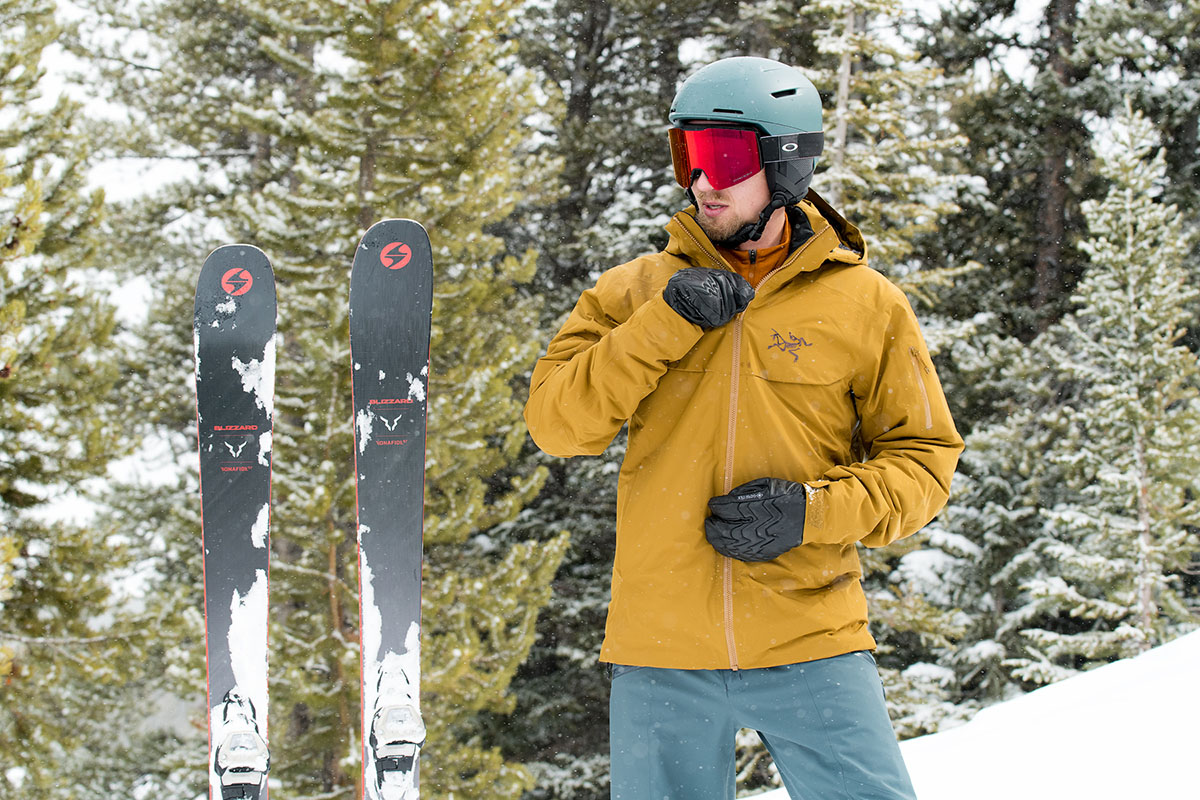
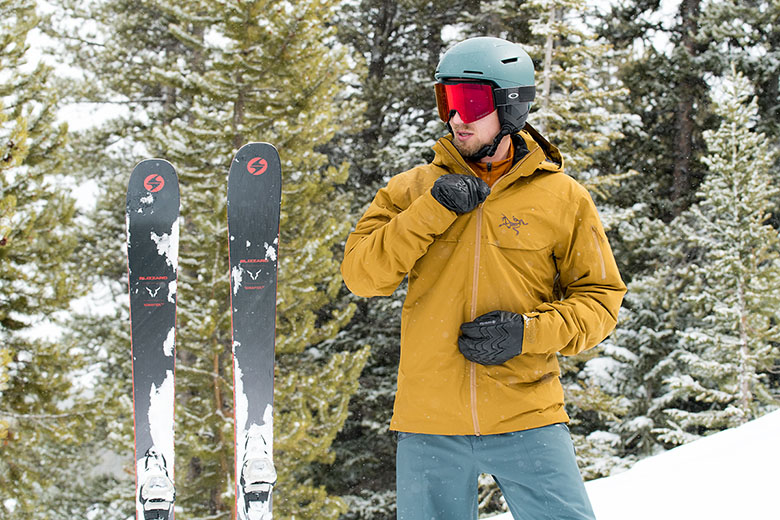
Switchback Travel (Jason Hummel)
Price: $1,100
Waterproofing: 3L Gore-Tex
Insulation: 750-fill down; 60, 100, & 140g Coreloft
What we like: Luxurious warmth; crosses over nicely between skiing and everyday use.
What we don’t: Extremely expensive and runs hot in mild conditions.
See the Men's Arc'teryx Macai See the Women's Arc'teryx Nita
Sitting atop Arc’teryx’s venerable ski lineup is the Macai: a Gore-Tex-equipped, down-insulated ski shell built for frigid conditions and serious resort use. Two of our testers put the Macai through a season-long test in Washington State and found it to be incredibly capable and versatile. While it’s overkill in mild weather and is a major hit to your wallet, the Macai is supremely warm and truly luxurious on cold days, plus the design crosses over well for daily wear. Below we break down our experiences with the Macai Jacket. To see how it stacks up to the competition, see our articles on the best ski jackets and best winter jackets.
Editor’s note: We tested the past-generation Macai Jacket for this review, and Arc’teryx has since updated the design with a revised fit that’s roomier in the midsection and thicker Coreloft insulation along the shoulders, side panels, cuffs, and hood. The latest Macai is also a little lighter and has a fixed powder skirt (the prior version’s was removable). We call out these changes where applicable below.
With a price tag exceeding $1,000, we set lofty expectations for the Arc’teryx Macai Jacket, and it mostly delivered. Using a 3-layer Gore-Tex construction (the vast majority of insulated jackets stick to 2 layers), the jacket performs like a full-on hardshell that happens to be lined with cozy goose down. The premium face fabric and durable water repellent (DWR) coating effectively shed moisture, the jacket feels nearly impervious in strong winds and blowing snow (a real joy when sitting on a frozen chairlift), and the adjustable hood fits nicely over a ski helmet and snugs down securely.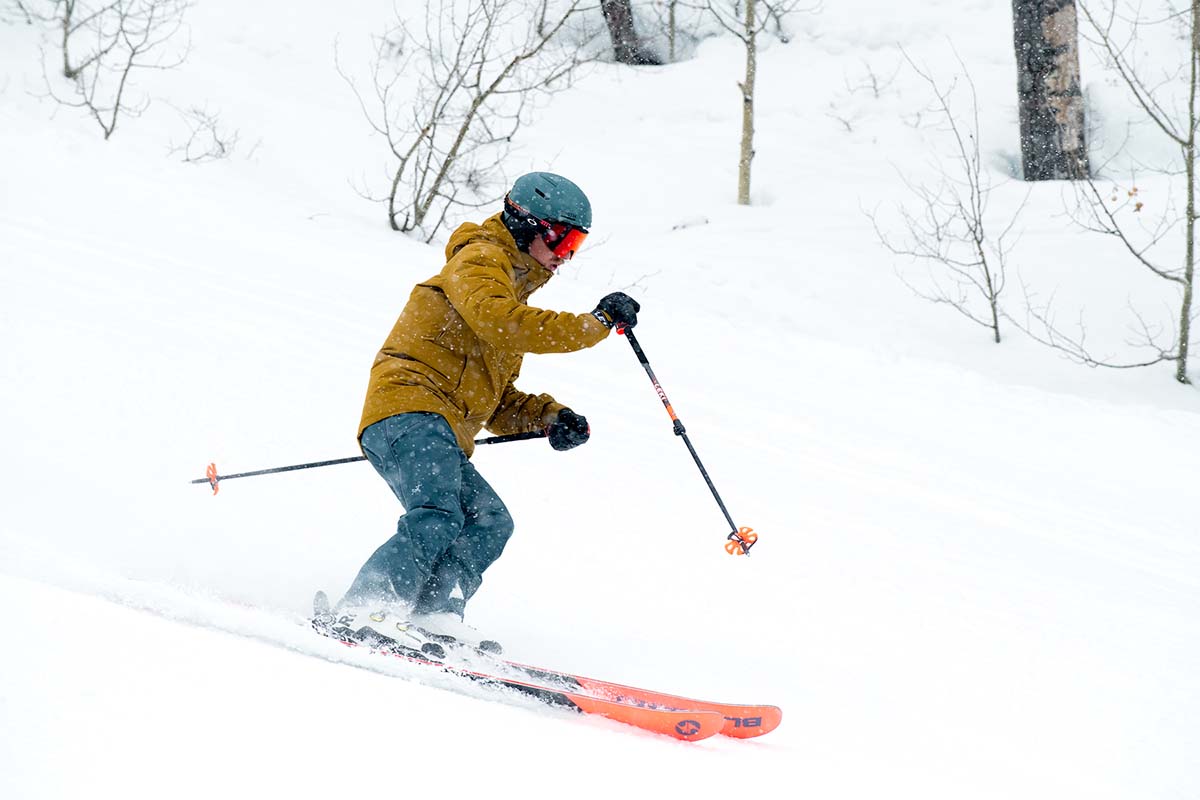
That said, Arc’teryx did make some concessions in performance to balance the Macai’s casual appeal (more on the latter below). First, the collar is fairly short and only reached my lower lip. Moreover, this area was surprisingly snug, which made it difficult to bury my face on blustery lifts. Further, the jacket isn’t particularly long with a back length of less than 30 inches—bending down to adjust my boots brought the hem up to my pants’ belt line (I’m 5’9” and had the medium size). The powder skirt does a decent job sealing around the waist, and you have dual cinches at the hem, but the jacket is more vulnerable than most premium designs to moisture creeping through the bottom in a fall or deep powder. Finally, we found it difficult to get a good seal around the wrists when wearing undercuff ski gloves. There’s no insulation at the end of the sleeves, so we had to secure the Velcro tightly to seal out cold air (this will be a non-issue with gauntlet-style gloves).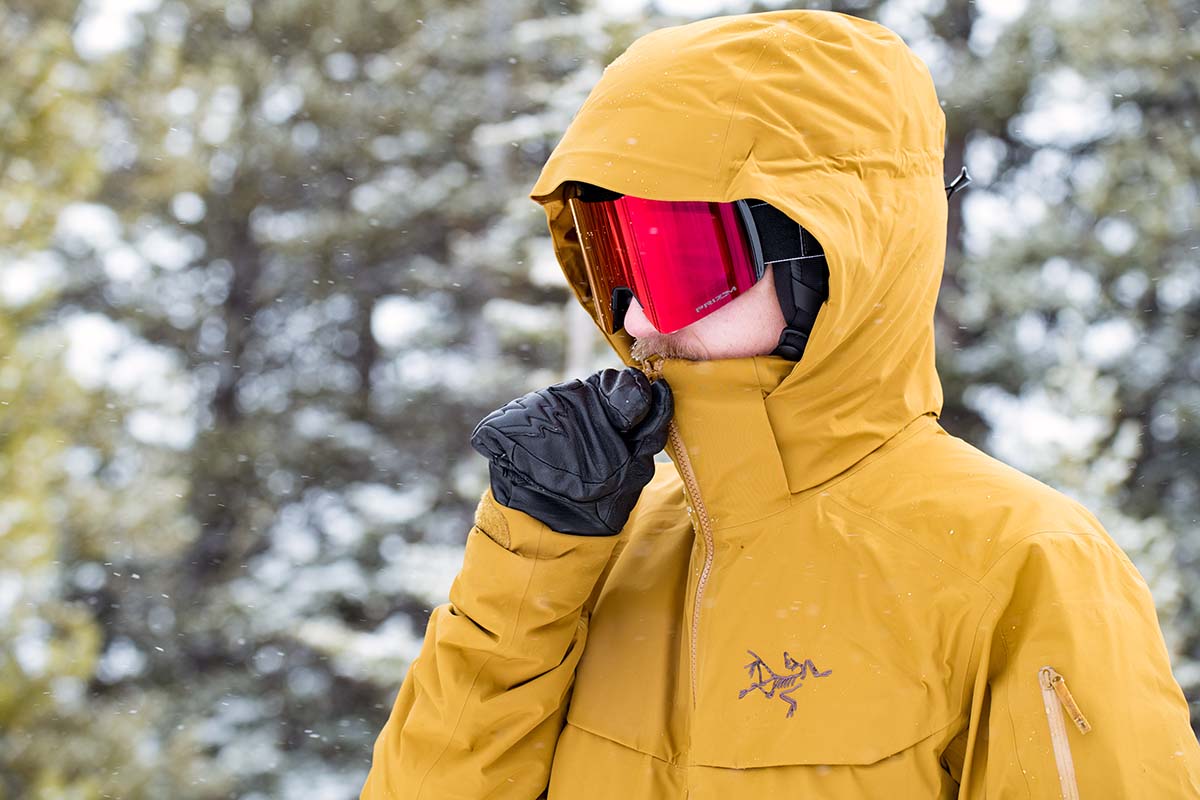
Using a creative mix of down and synthetic insulations, the Macai is a cozy place to be on even the coldest days. Around the core and sleeves, you get a healthy dose of high-quality, 750-fill down, which maximizes warmth while limiting bulk and weight. And in areas more vulnerable to moisture—including the hood, shoulders, underarms, cuffs, and hem—Arc’teryx included their well-regarded Coreloft synthetic fill (a mix of 60, 100, and 140g). In practice, the combination was warm enough to allow me to comfortably wear only a baselayer while lapping groomers on cold days that dipped into the low teens Fahrenheit (and far lower factoring in wind chill). We didn’t experience any truly frigid conditions during testing to push the jacket’s limits farther, but I suspect it would’ve kept me comfortable close to 0 degrees without needing to add additional layers.
The downside to all that warmth is that the jacket is overly insulated for mild temperatures and sidecountry hikes. In practice, I found myself reaching for the pit zips to partially open them on windless days with temperatures in the mid-to-high 20s. With the pit zips open, I was able to stay comfortable, and the mesh that covers the zipper openings did a nice job at keeping snow from streaming through (a common problem with opening pit zips while skiing downhill or in really gusty and snowy weather). All things considered, the Macai is hard to beat for frigid on-piste days, but unless you run very cold or only ski in below-freezing temperatures, you’ll need a second ski shell in your quiver for mild weather.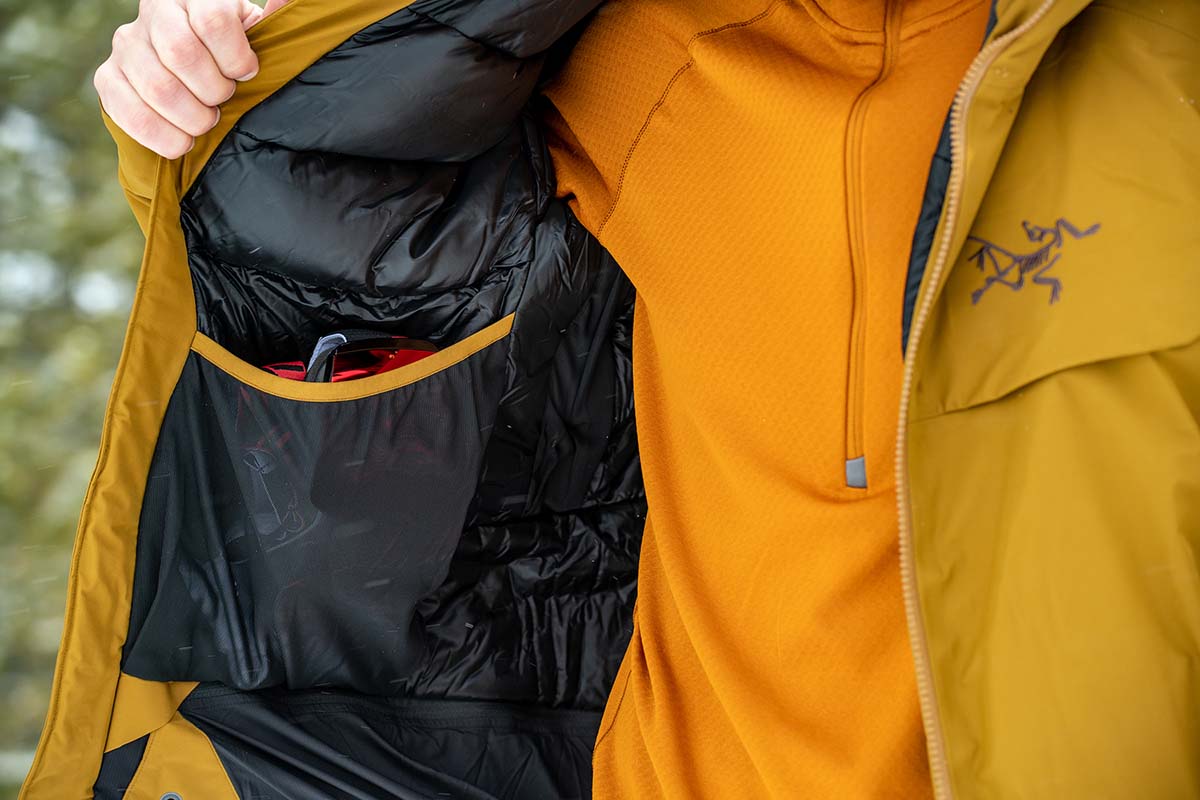
Ski shells typically are functional pieces that prioritize protection over outright luxury, but the Arc'teryx Macai Jacket is a rare exception. Slipping it on is like putting on a premium down jacket: The soft baffles along the interior slide easily over a baselayer and have a high-end feel, and the jacket’s trim fit practically hugs you in warmth (note: The latest version is roomier than the design we tested, which we cover in “Fit and Sizing” below). Additionally, all of the touch points are well-executed: There’s a small patch of fleece at the front of the collar, and the back of the neck and interior of the hand pockets have a smooth and plush lining. Finally, the well-tailored design includes nice details like gussets under the arms to enhance mobility. All told, we had zero complaints about the Macai from a comfort perspective.
More than any ski shell I’ve tested, the Macai stuck out as a fully serviceable everyday winter jacket. To start, it looks the part with clean lines, a fairly trim fit that isn’t overly bulky or long when worn over just a t-shirt (again, the latest Macai is roomier than the version we tested), and Arc’teryx even went as far as including small fabric flaps over the hand pockets and exterior chest pocket. Moreover, the hood cinches down evenly, isn’t cumbersome when only wearing a beanie or no hat at all, and is removable when the weather is favorable. One of the only features that gives the Macai away as a true ski shell is the sleeve pocket and its exposed zipper. In my opinion, this widespread appeal helps justify the jacket’s steep price tag.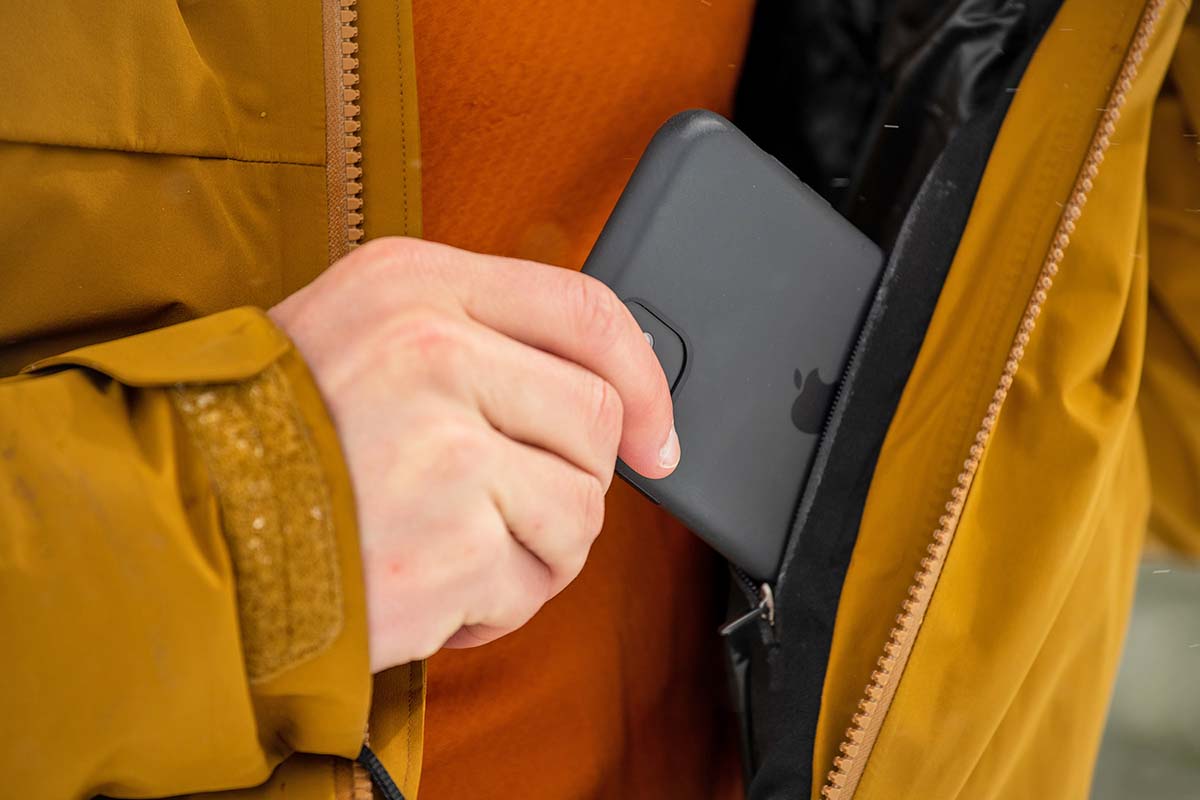
As an insulated resort shell—and one that includes down insulation—the Macai is unsurprisingly a poor ventilator. As with most insulated designs, I found myself quickly needing to unzip the front of the jacket to dump heat even on short sidecountry hikes in windy conditions with temps in the mid teens (and with the pit zips open from the start). The pit zips do a decent job keeping you comfortable—and I relied on them heavily throughout the season—but the sheer amount of insulation limits the jacket’s appeal to those who stay within the ropes. Of note: Arc’teryx now offers the jacket in an uninsulated version that’s considerably lighter (1 lb. 11.3 oz.) and more breathable.
Sitting atop Arc’teryx’s already-spendy ski shell lineup, it came as no surprise the Macai Jacket delivered from a quality standpoint. From the moment you put on the jacket, it has a special feel, from the plush and cozy interior to the sturdy and smooth zippers. We haven’t had any hiccups in terms of reliability, either: All the zippers and drawcords are functioning well, and after a couple wash cycles throughout the winter, the shell still looks and performs like new. Arc’teryx lists the Macai’s face fabric as 40-denier (D), which falls on the thin end of the spectrum, but you’d never know that wearing it. The 3-layer design, combined with the thick insulation underneath, gives it a burly feel. In the end, I was fully confident even skiing in trees and around sharp gear. Along with the high-end insulation, this is the kind of shell that should have a very long lifespan.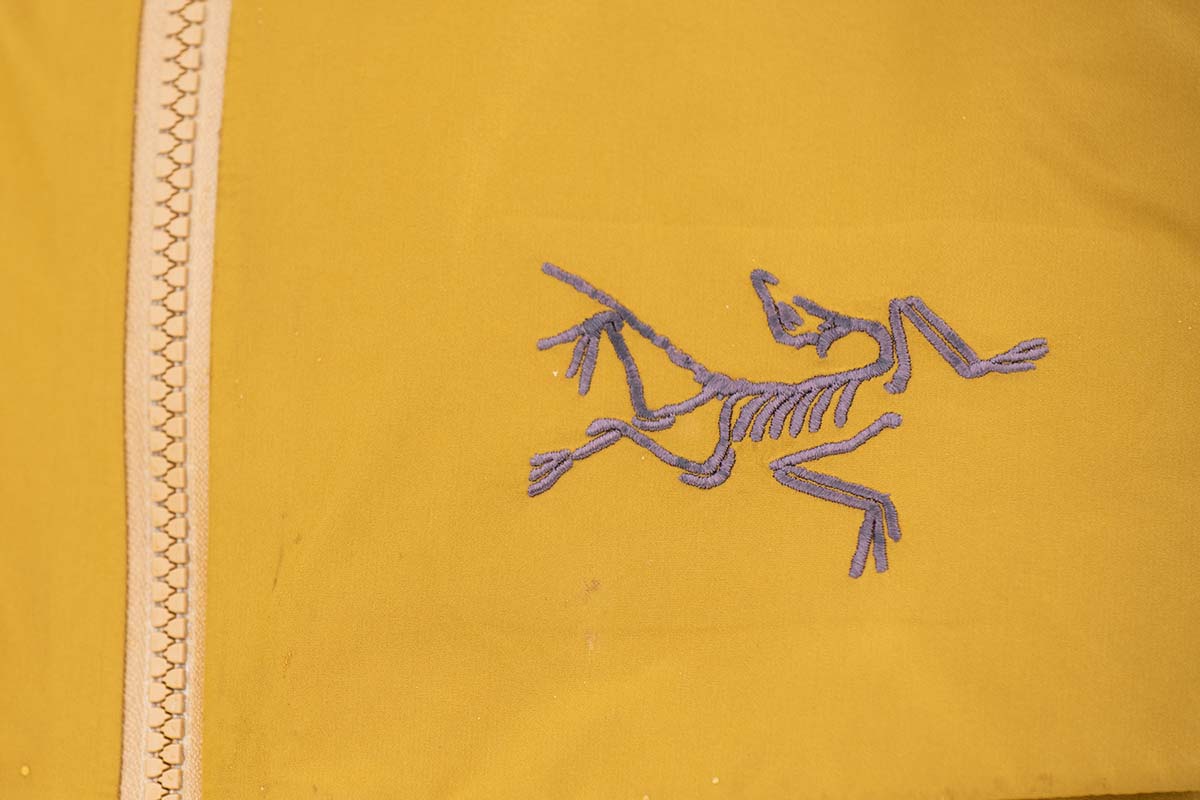
I typically avoid insulated jackets due to their bulky and somewhat sloppy feel, but the Macai bucks another trend here. The combination of its excellent fit and mobility, lofty down and synthetic insulations, and premium shell and lining materials make it feel lighter than its listed 2-pound-4-ounce weight (note: The latest version is a little lighter at 2 lb. 2.9 oz.). For reference, it’s noticeably lighter than Helly Hansen’s Alpha 4.0 (2 lb. 8.6 oz.) while stacking up competitively to other moderately insulated designs like the Norrøna Lofoten Gore-Tex Insulated (1 lb. 14 oz.) and Patagonia Insulated Powder Town (1 lb. 14.7 oz.). Clearly, this is not a jacket you’ll be stuffing into a pack and bringing into the backcountry, but its weight is a non-factor and won’t hold you back on full days at the resort. 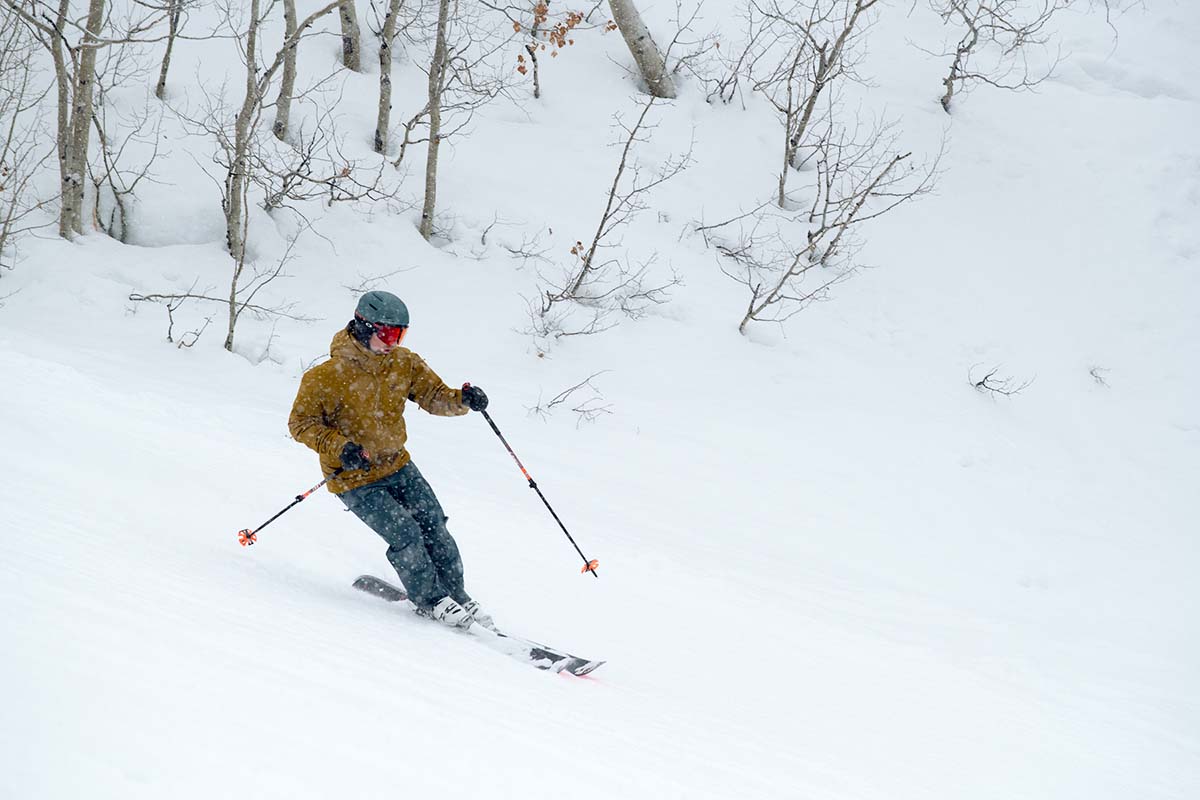
Taking a closer look at some of the features, the Macai uses Arc’teryx’s DropHood design that lines up well with the jacket’s intentions. In this insulated application, it fit nicely over our medium-sized helmets (Smith’s Level and POC’s Obex) and stayed securely in place even in inclement weather. Peripheral vision was also quite good, although we did find side to side movement was a little more restricted than we’ve experienced in some other Arc’teryx ski shells (including the popular Sabre Jacket, which uses their non-removable StormHood design). The upside to the lower-profile design is that it cinches down surprisingly well for use without a ski helmet, adding to the jacket’s everyday appeal. And for bluebird days or warm spring outings, the hood can be quickly removed with a series of buttons along the sides and back of the collar.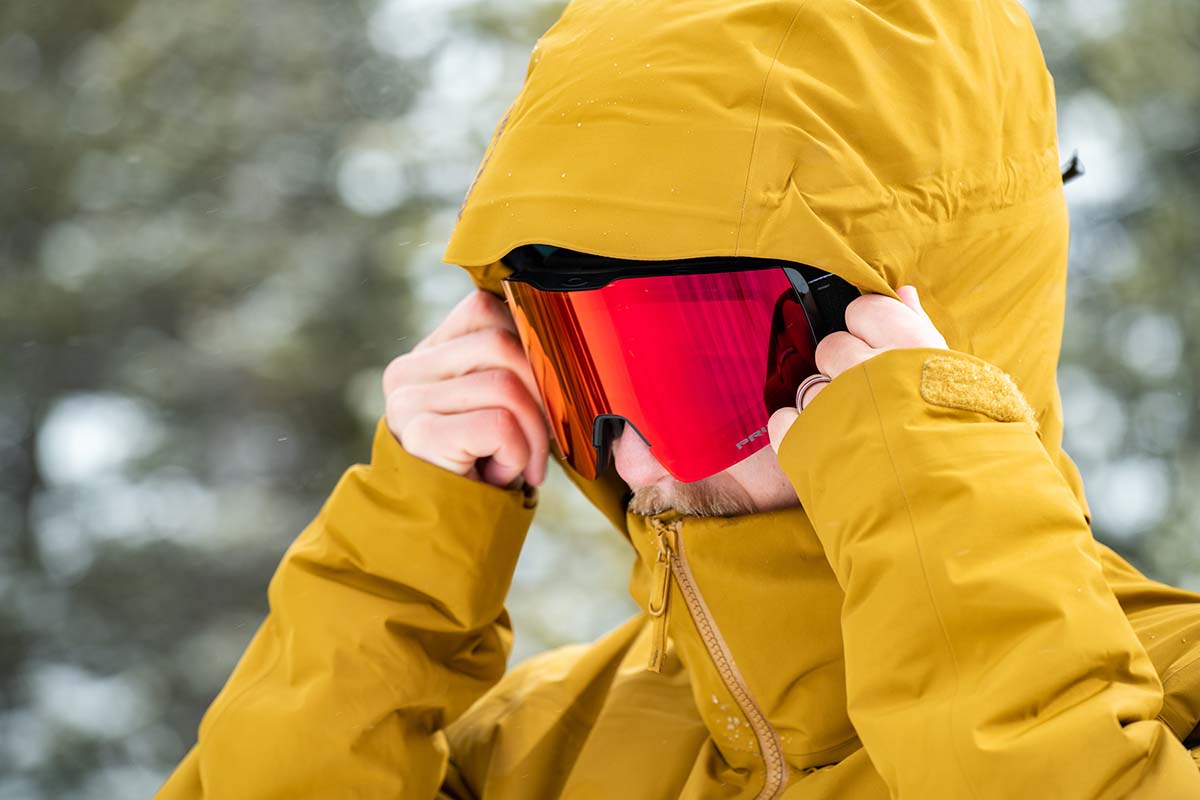
Organization is another strong suit of the Macai’s design. The jacket includes two large hand pockets, which are a nice size for gloved hands, and the right hand pocket stores a fabric goggle wipe. Hidden underneath a flap at the left side of the chest is a small zippered pocket that’s just about perfect for storing a credit card or other compact items. And rounding out the exterior, you get a sleeve pocket that’s positioned nicely for RFID ski passes. On the inside, there’s a very large zippered pocket that easily swallows a large smartphone and a mesh dump pocket on the other side for stuffing gloves or ski goggles.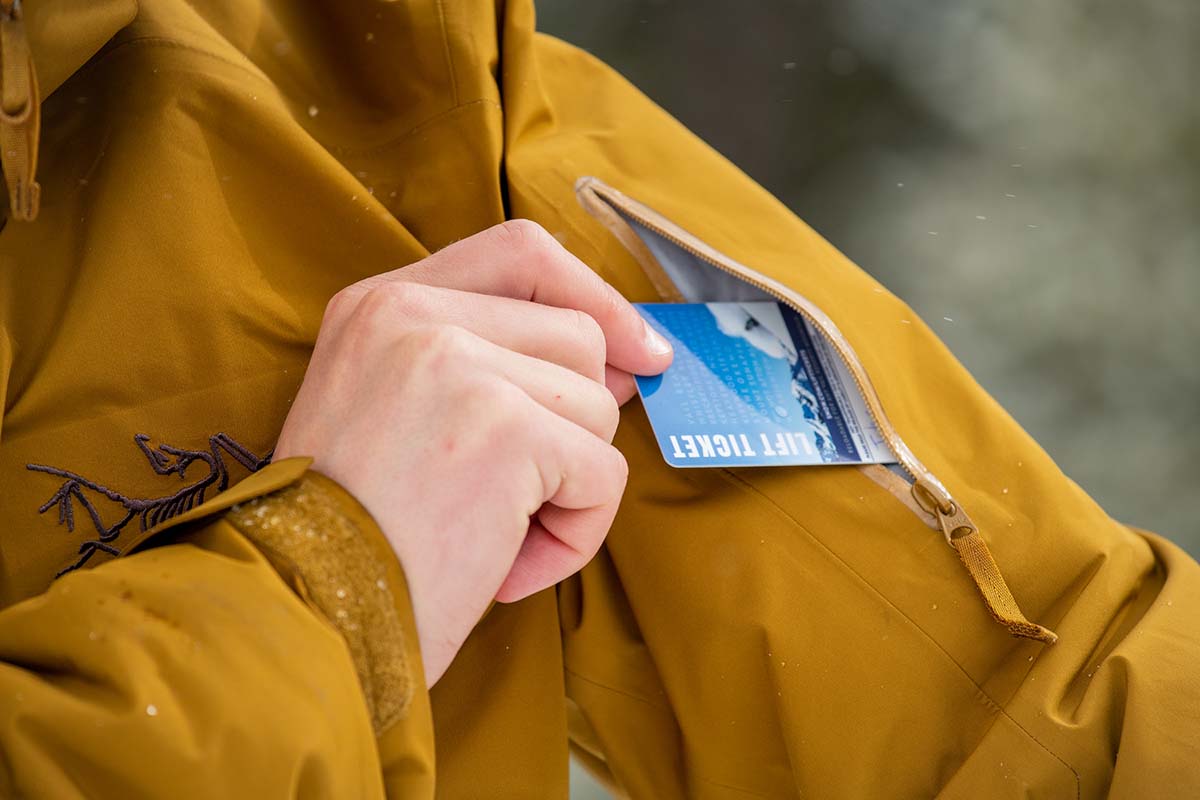
As with most ski-specific shells, the Macai includes a powder skirt to seal out snow in the event of a fall or deep powder. The skirt features a silicone-like band to keep it in place and two sets of buttons to tune the fit. Given the shorter cut of the jacket, I was inclined to use the powder skirt a fair amount to keep the cold and wet out, and it proved to be effective and stayed nicely in place. It’s worth noting that the skirt isn’t removable on the latest Macai—our jacket’s skirt zipped out for easy streamlining—but it’s still a very practical and well-executed design.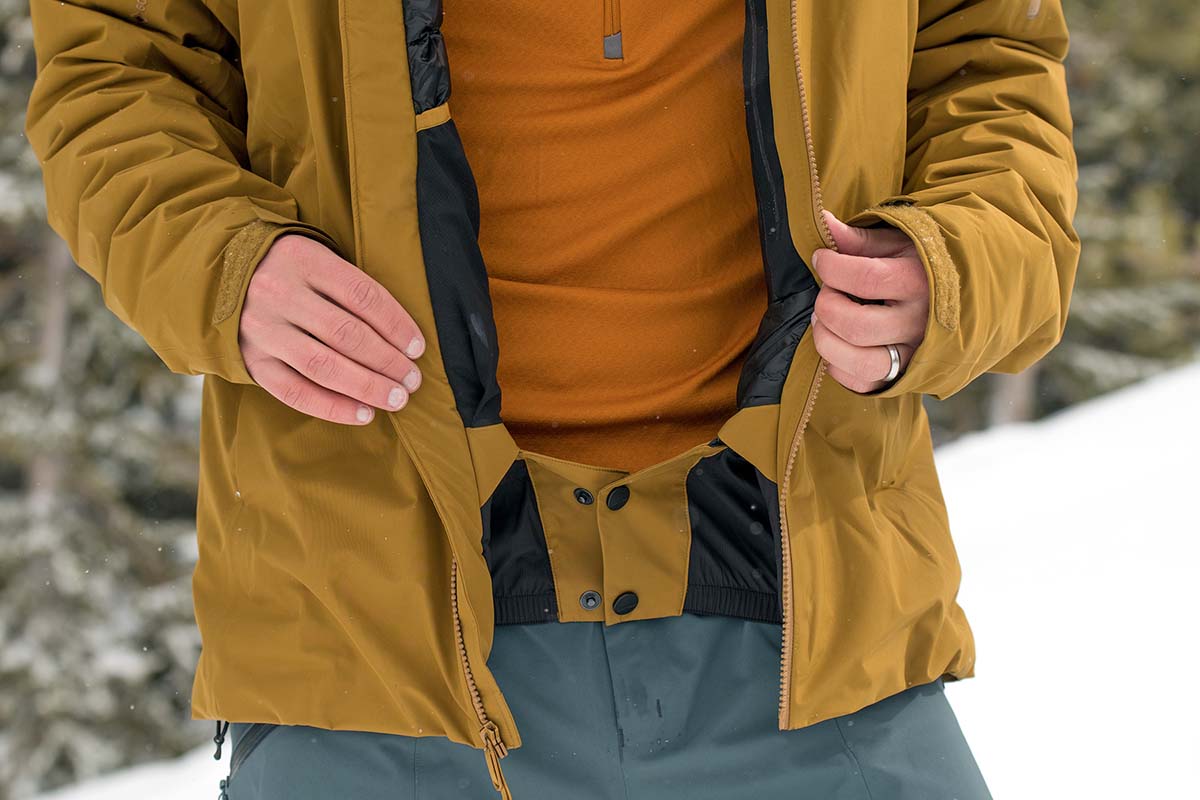
Both of our testers (who are 6’0” and 165 lb. and 5’9” and 155 lb.) wore the past-generation Macai in a size medium and found the fit to be spot-on. That said, despite boasting the same “regular” designation, the latest iteration has a revised fit that’s roomier through the chest, waist, hips, and thighs. For reference, the model that we tested was moderately snug and ideal for wearing with just a baselayer underneath, but recent reviews indicate that the updated fit has some intricacies. According to Arc’teryx, the medium size remains unchanged, while smaller sizes fit tighter, and larger sizes fit looser. We’ll update this review with our take once we test the latest Macai.
The latest Macai Jacket clearly highlights Arc’teryx’s ongoing focus on sustainability. First, the down insulation is certified to the Responsible Down Standard (RDS), which ensures the geese were treated humanely and not subjected to practices like force-feeding or live-plucking. The Macai also uses materials that are bluesign-approved, indicating that they’ve undergone thorough testing and have been deemed safe for workers, consumers, and the environment. Some competitors tack on additional measures like recycled fabrics and PFC-free DWR coatings that forgo the use of per- and polyfluorinated chemicals, which we hope to see in a future update.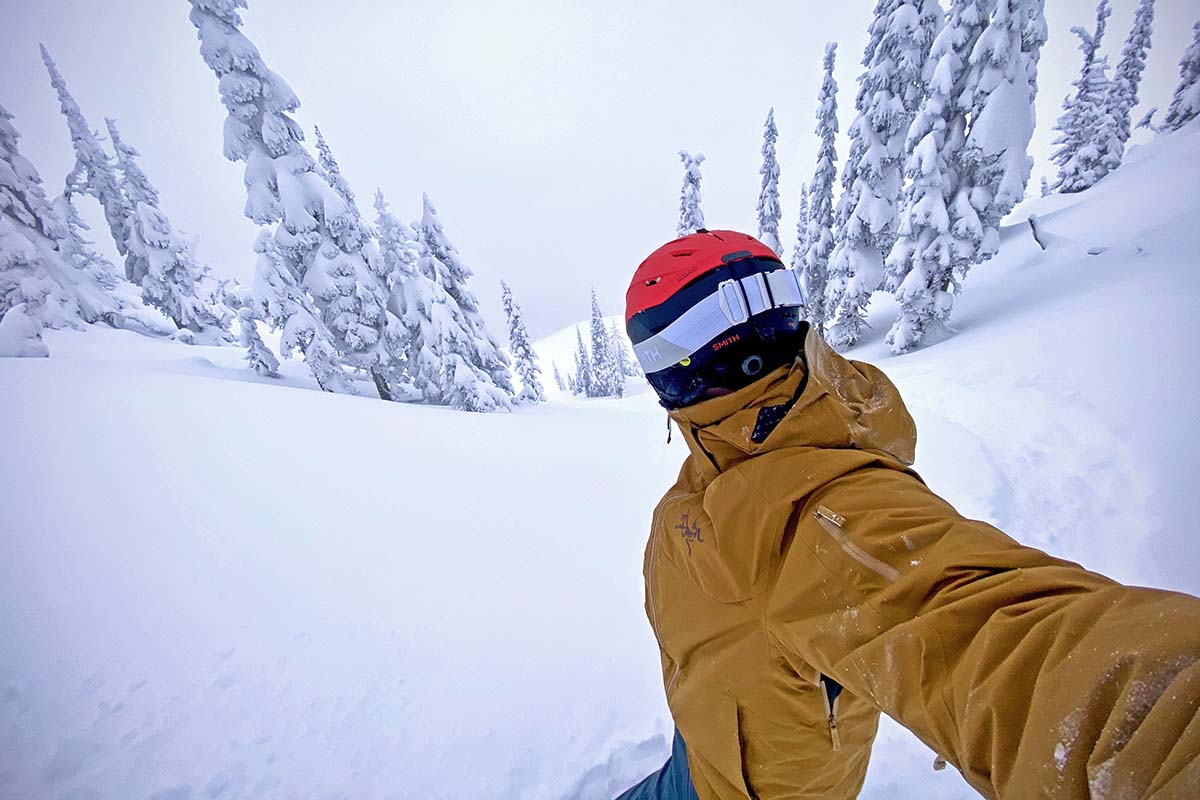
We put the Macai Jacket to the test on the slopes, and Arc’teryx also makes a pant to complete your kit. The Macai Pant costs $600 and weighs 1 pound 8.7 ounces but features a fitted (rather than regular) cut, uses only synthetic insulation (80g Coreloft Compact), and boasts a 2-layer Gore-Tex shell. For those who like to tailor their layering system based on conditions, the Macai Shell Jacket ($750) is uninsulated and much lighter and more breathable than the design tested here. And for a nice middle ground, the Macai Lightweight Jacket ($800) is moderately insulated with a mix of 750-fill down and 60g Coreloft Compact. On the women’s side, the Nita Down Jacket is a little less expensive and lighter than the Macai but largely similar in terms of protection and features. Rounding out the women’s collection are the uninsulated Nita Shell Jacket and Nita Insulated Pant.
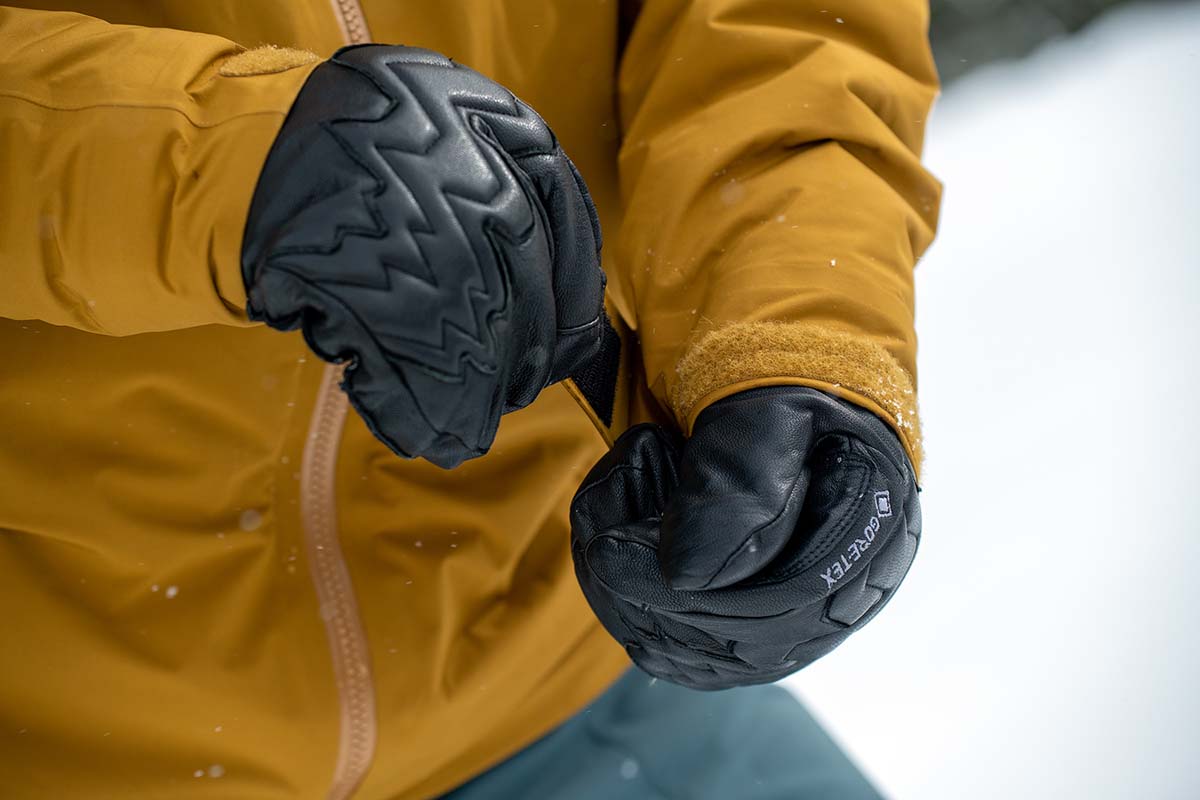
| Jacket | Price | Best For | Insulation | Waterproof | Weight |
|---|---|---|---|---|---|
| Arc'teryx Macai Jacket | $1,100 | Resort/casual | 750-fill down & Coreloft | 3L Gore-Tex | 2 lb. 2.9 oz. |
| Arc'teryx Sabre Insulated | $850 | Resort | 80g Coreloft | 2L Gore-Tex | 1 lb. 12.7 oz. |
| Arc'teryx Macai Lightweight | $800 | Resort | 60g Coreloft Compact | 3L Gore-Tex | 1 lb. 14.2 oz. |
| Helly Hansen Alpha 4.0 | $475 | Resort | 80g PrimaLoft Black | 2L Helly Tech | 2 lb. 8.6 oz. |
| Norrøna Lofoten GTX Insulated | $549 | Resort | PrimaLoft Silver Eco | 2L Gore-Tex | 1 lb. 14 oz. |
Arc’teryx’s Macai is a top-notch resort ski jacket that can effectively pull double duty for daily wear, which is no easy feat. For a step down in price, Arc’teryx also offers their popular Sabre Jacket in an insulated version that shares the excellent build quality and attention to detail in a slightly less everyday-friendly package. In this case, Arc’teryx opted for a 2-layer Gore-Tex shell with a moderate (80g) dose of Coreloft synthetic. Along with a drop in warmth, this makes the Sabre both lighter (1 lb. 12.7 oz.) and more breathable, although neither option is ideal for frequent backcountry use. Other differences include a noticeably thicker (80D) shell, longer back length, a less restrictive (but not removable) StormHood, and five total pockets (the Macai has six). Again, the Macai crosses over better for around-town use, but we consider the Sabre the superior all-rounder due to its lighter, cheaper, and less insulated build.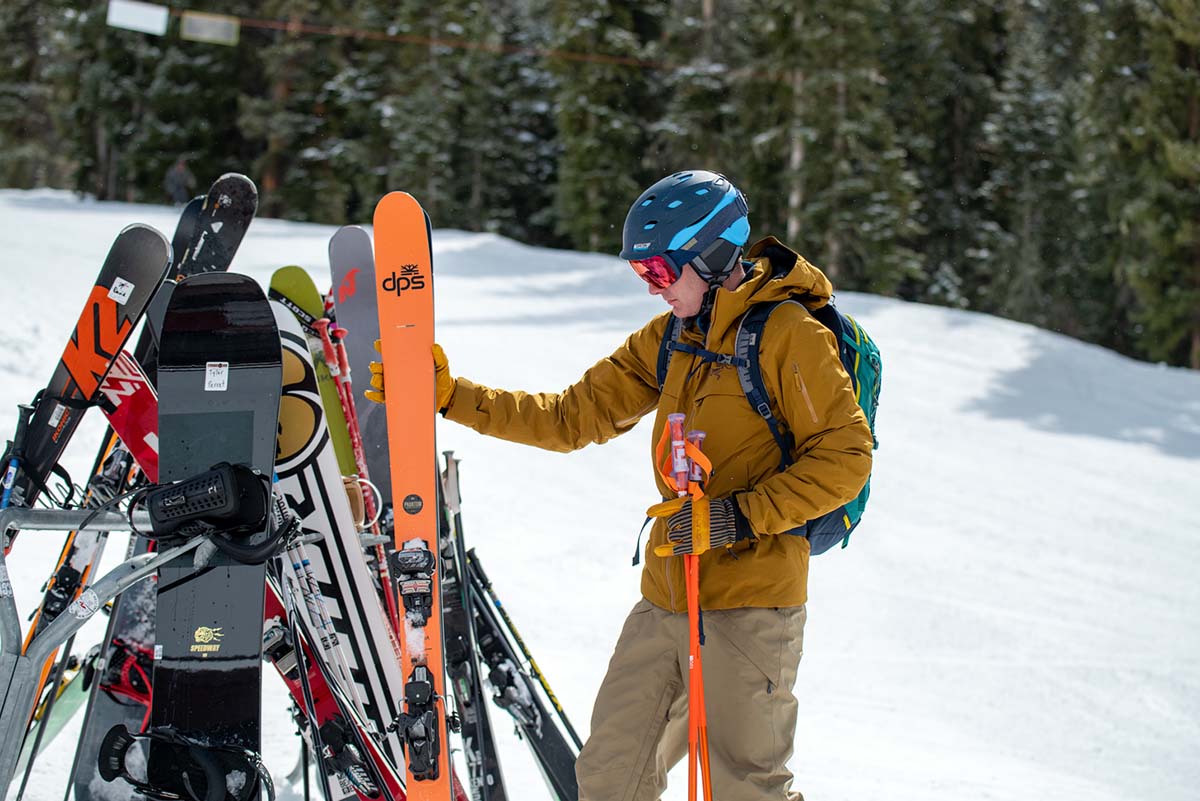
From within the same Macai collection, the Macai Lightweight Jacket is arguably the more approachable option for many. For a significant $300 less than the standard Macai, the Lightweight retains a 3-layer Gore-Tex shell and 750-fill down insulation but swaps in thinner Coreloft Compact (60g) synthetic in moisture-prone areas. This translates to a noticeable drop in both weight (1 lb. 14.2 oz.) and bulk, along with a boost in breathability. Importantly, most other features are the same, including a helmet-compatible DropHood, mesh-backed pit zips, and six pockets to stash the essentials. If you exclusively ski in frigid conditions, the Macai could be worth the added investment. Otherwise, we think most skiers—especially those who already own a quality midlayer—will be perfectly happy with the Macai Lightweight.
Moving outside of Arc’teryx’s lineup, Helly Hansen’s Alpha (recently updated to the “4.0”) has been our top-rated insulated resort shell for years. What we love about the design is its stretchy and extremely comfortable fit. The cut is trimmer than the Macai, but the tailoring is excellent, and the construction has plenty of give for active use. In addition, Helly Hansen nailed all the details with plenty of pockets, an adjustable hood (although it's less secure than the Macai's), lots of color options, and quality extras like a dedicated insulated pocket for storing a phone (for more, see our in-depth Alpha 4.0 review). It’s true that the Alpha 4.0’s face fabric and in-house 2-layer build can’t match Gore-Tex in outright weather protection, and it’s not as warm as the Macai with 80g PrimaLoft synthetic fill, but it’s not far off in either respect and saves you over $600 in the process.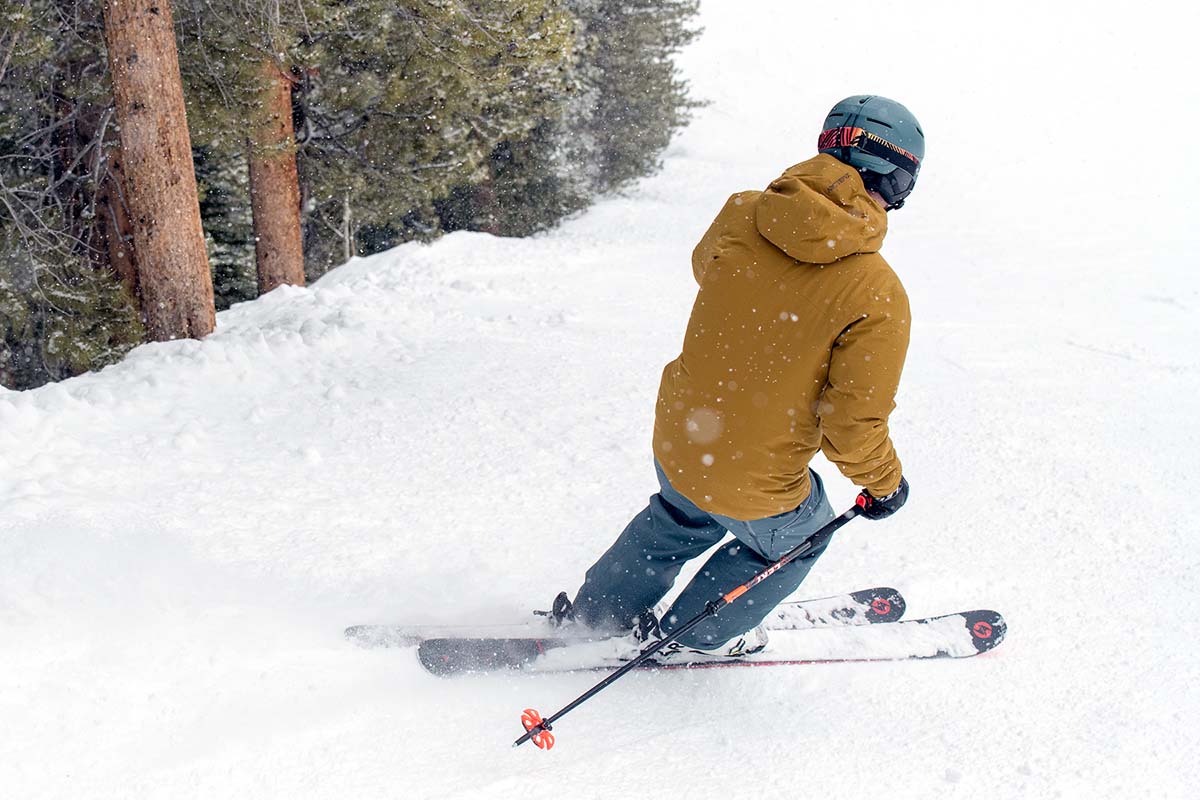
A final option to consider is Norrøna’s Lofoten Gore-Tex Insulated Jacket. The Lofoten has a decidedly more technical look than the Macai but offers reliable waterproofing thanks to its burly 2-layer Gore-Tex construction. It also includes thoughtful and functional touches like stretch hand gaiters and a goggle wipe. In addition, the jacket is more versatile for a range of temperatures with less insulation in the design—in fact, the hood and hem forego insulation altogether. Taken together, the Norrøna is more tailored to active skiers who head off-piste and do some hiking, but it lacks the cozy and luxurious feel of the Macai for frigid conditions.
If you’re thinking about buying gear that we’ve reviewed on Switchback Travel, you can help support us in the process. Just click on any of the seller links above, and if you make a purchase, we receive a small percentage of the transaction. The cost of the product is the same to you but this helps us continue to test and write about outdoor gear. Thanks and we appreciate your support!
Depending on the seller, most products ship free in the United States on orders of $50 or more. International shipping availability and rates vary by seller. The pricing information on this page is updated hourly but we are not responsible for inaccuracies.